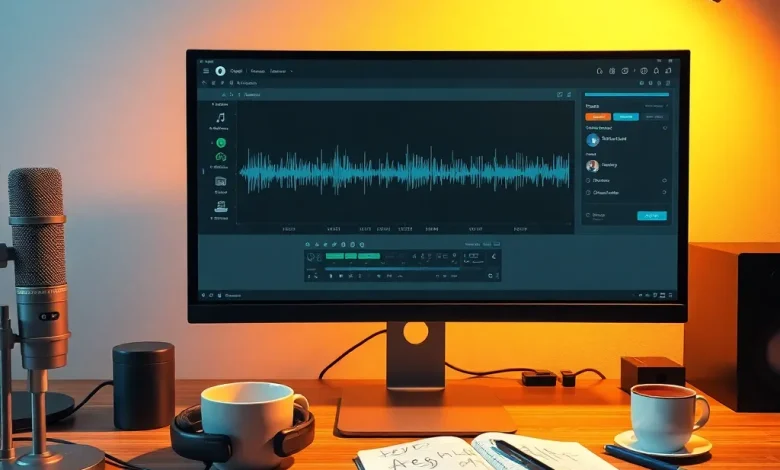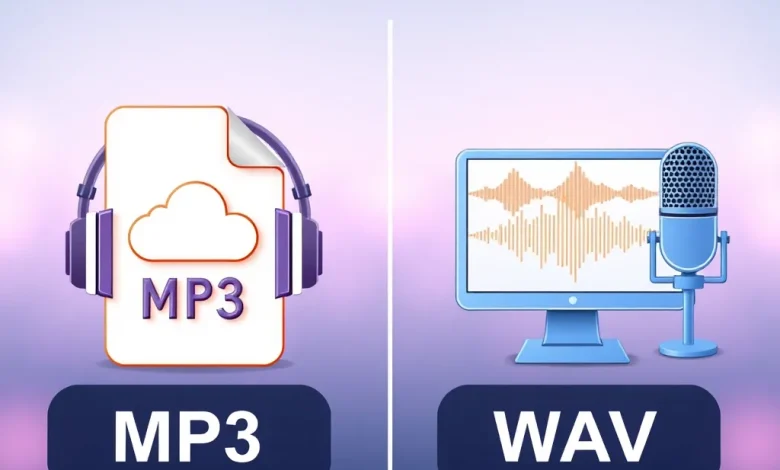Introduction
In today’s content-driven world, AI voiceovers have become an essential tool for creators, educators, marketers, and developers. Whether you’re producing a podcast, eLearning module, YouTube video, or audiobook, selecting the right audio format—MP3 or WAV—can significantly impact your output quality, file size, and user experience.
In this detailed guide, we’ll break down MP3 vs WAV in the context of AI-generated speech and TTS (Text-to-Speech) solutions. We’ll help you decide which format works best for your needs and explore tools like MP3, Wav voice converters and MP3-to-text converters to boost your productivity.
Audio Formats in AI Voiceovers

AI voiceovers and TTS systems have revolutionized how we generate voice content. However, one crucial decision remains: what audio format should you use for your output? The two dominant formats are MP3 and WAV, each with its pros and cons.
Understanding the difference between MP3 vs WAV can improve not just your audio quality but also compatibility, storage, and future edits.
What Is MP3?
MP3 (MPEG-1 Audio Layer III) is a compressed audio format known for its small file sizes and good-enough quality. It is the most widely used audio format and is compatible with almost every device and platform.
Advantages of MP3:
- Compressed (smaller size)
- High compatibility
- Ideal for online streaming
- Faster to upload/download
Disadvantages:
- Lossy compression (some quality is lost)
- Not suitable for detailed editing
What Is WAV?
WAV (Waveform Audio File Format) is an uncompressed audio format, developed by Microsoft and IBM. It stores raw audio data and preserves the highest possible audio fidelity.
Advantages of WAV:
- Lossless and uncompressed
- Superior audio quality
- Best for editing and mastering
Disadvantages:
- Large file sizes
- Limited compatibility with some web platforms
Key Differences Between MP3 and WAV

| Feature | MP3 | WAV |
|---|---|---|
| Compression | Lossy | Lossless |
| File Size | Small | Large |
| Audio Quality | Medium to High | High |
| Editing Flexibility | Limited | Excellent |
| Compatibility | Universal | Mostly desktop, less web |
| Best Use | Streaming, web, mobile | Editing, archiving, broadcast |
MP3 vs WAV: Which One Should You Choose?
If you’re using Text-to-Speech (TTS) to generate voiceovers, the choice between MP3 and WAV will depend on your end use.
- Use MP3 for: podcasts, YouTube videos, website integration, eLearning with size limitations.
- Use WAV for: professional voice production, editing, dubbing, films, and mastering.
Use Cases
When to Use MP3
MP3 is preferred when:
- File size matters
- You’re hosting voice content online
- Bandwidth is limited
- Voice is final and doesn’t need editing
Example:
If you’re uploading a tutorial on YouTube, an MP3 voiceover is perfect due to small size and fast load time.
When to Use WAV
WAV is ideal for:
- Voiceover professionals
- Audio engineers
- Projects requiring post-production
- High-quality applications (e.g., VR, gaming)
Example:
If you’re creating a voiceover for a high-fidelity film or immersive VR content, WAV is the go-to.
MP3 Voice Converter Tools You Should Know
Sometimes, TTS tools output audio in WAV, and you may want to convert it to MP3. Here are some popular MP3 voice converter tools:
- Audacity (Free, Open-source)
- OnlineConvert (Web-based)
- Speakatoo TTS – Offers both MP3 and WAV downloads
MP3 to Text Converter: The Reverse Side of TTS
While TTS converts text to speech, the reverse process involves converting MP3 to text using ASR (Automatic Speech Recognition).
Popular MP3 to text converters:
- Google Speech-to-Text
- IBM Watson
- Speakatoo Speech-to-Text Tool
If you’re transcribing podcasts or interviews, Speakatoo TTS tools save hours of manual effort.
MP3 to Text Converter: The Reverse Side of TTS
While TTS converts text to speech, the reverse process involves converting MP3 to text using ASR (Automatic Speech Recognition).
Popular MP3 to text converters:
- Google Speech-to-Text
- IBM Watson
- Speakatoo Speech-to-Text Tool
If you’re transcribing podcasts or interviews, Speakatoo TTS tools save hours of manual effort.
How File Format Affects AI Voiceover Quality
AI voiceovers rely on precise pronunciation, pacing, and tone. While MP3 retains decent quality, WAV provides crystal-clear output with no compression artifacts.
Choosing the right format ensures that your audience hears exactly what the AI intended to say—without noise or distortion.
Conclusion: Choosing Smartly for Your Voice Project
So, TTS MP3 vs WAV—what’s the verdict? It depends on your goals.
Use MP3 when you want:
- Smaller files
- Fast uploads
- Compatibility across platforms
Use WAV when you need:
- High-fidelity audio
- Flexibility for editing
- Professional-grade outputs
To learn more or try Speakatoo’s Indian TTS voices, visit https://www.speakatoo.com
